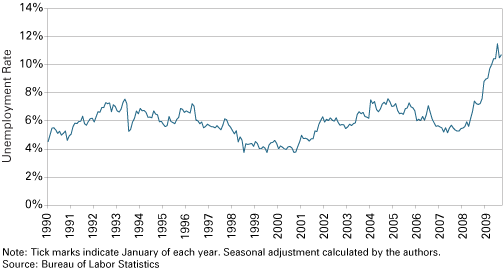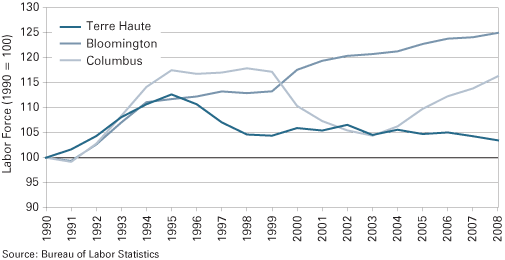Terre Haute Forecast 2010
Associate Professor of Economics, Rose-Hulman Institute of Technology
Professor of Economics, Indiana State University
November 2009
The Terre Haute metro area exits the recession of 2007–2009 in much worse shape economically than when the recession began, due largely to the departure of Pfizer. As Figure 1 shows, the area unemployment rate began escalating when Pfizer laid off all of the production workers associated with the ill-fated drug Exubera in the fall of 2007, and continued its upward climb when Pfizer announced (in 2008) that it was closing its Terre Haute facility. Combined with a national recession that hit Terre Haute’s retail sector hard, as well as diminished demand for products from local manufacturing firms such as Sony DADC, Boral Brick, Certainteed, Bemis, Applied Extrusion Technology, and Great Dane, the Wabash Valley economy will enter 2010 in the worst condition in decades.
Figure 1: Terre Haute Metro Unemployment Rate (Seasonally Adjusted), 1990 to 2009

While the rise in the local unemployment rate largely mirrors the cyclical national pattern, the reduction in the total number of jobs in the Terre Haute area is more troubling. Total employment is down more than 10 percent (from 77,460 to 69,615) from the beginning of the recession, and the local labor force, while essentially remaining stagnant since 1998, has experienced a noticeable decline over the last two years (see Figure 2). This decline illustrates what economists call the “discouraged worker effect,” and helps explain the dip in the local unemployment rate in the third quarter of 2009. This dip occurred only because many of the unemployed left the labor force rather than continuing to look for work. Approximately half of the reduction in the labor force was attributable to those discouraged workers (see Table 1). Whenever that happens, the unemployment rate will fall, but not for the reasons one might hope.
Table 1: Terre Haute Metro Labor Force Statistics, June to September 2009*
| Month | Labor Force | Employed | Unemployed | Unemployment Rate |
| June | 79,817 | 71,157 | 8,660 | 10.8 |
| July | 79,199 | 70,711 | 8,488 | 10.7 |
| August | 77,404 | 69,470 | 7,934 | 10.3 |
| September | 76,848 | 69,615 | 7,233 | 9.4 |
*Not seasonally adjusted
Source: Bureau of Labor Statistics
Figure 2 also illustrates that in terms of generating job opportunities for the local population, the Terre Haute regional economy is falling behind nearby metropolitan areas of similar size. While the Columbus regional economy exhibits greater cyclical fluctuation, a labor market feature that is not enviable, the other important message in this figure has to do with long-term labor market health. After keeping pace with Bloomington and Columbus in terms of relative growth of the labor force up to 1995, the Terre Haute regional economy has fallen behind in terms of its ability to provide jobs for the local population. Such labor market weakness, if chronic, will contribute to population exit and brain drain that will weaken longer-term prospects for the area economy.
Figure 2: Labor Force Index for Terre Haute, Bloomington, and Columbus Metros

Having said all this, there are a few potential “green shoots” that may spring from what has been an otherwise tremendously difficult recession for the city and region. Union Hospital, together with the leading physicians group in the area (Associate Physicians and Surgeons), will soon open its $175 million expansion. CSN, Greenleaf, Chem-Chem, and Kellogg all opened or expanded facilities in the last year, and PolyOne, AET, and Novelis (the spin-off from Alcan) each brought production from less profitable locations to Terre Haute during the year. Alorica, which opened a call-center facility in Terre Haute in early 2008, quickly exceeded its employment goals, reflecting a trend toward the return of call centers to the United States. The I-70–IN 46 intersection is also seeing activity once again; the Terre Haute Convention and Visitors Bureau and three local banks completed construction in 2009; and a new Holiday Inn Express is under construction as 2009 comes to a close. The single largest potentially positive news could come in the form of a defense subcontract that Unisone Engine Components hopes to land with GE should the Joint Strike Fighter defense program become reality.
Pfizer’s departure, though it has left a significant hole in the budget of the city, county, and local United Way, also comes with an opportunity. The land and facility have been sold to the county for a very small fraction of what the 845-acre, 383,000 square foot facility is worth. Though currently idle, much of the facility was built in anticipation of Exubera sales and was never used. Because it was never used, much of the space is in nearly move-in condition for a manufacturer.
The hoped-for turnaround in the national economy would likely benefit those elements of the Terre Haute economy that are cyclical. Those manufacturing operations that contribute to the cyclical rise in the local unemployment rate could also eventually lead to a rapid decline in that rate as Terre Haute plastic, aluminum, Blu-ray discs, bricks, and siding begin to sell once again.
Also in this Issue…
- Outlook for 2010
- International Outlook for 2010
- U.S. Outlook for 2010
- Financial Outlook for 2010
- Housing Market Outlook for 2010
- Indiana's Outlook for 2010
- Indiana's Agricultural Outlook for 2010
- Anderson Forecast 2010
- Bloomington Forecast 2010
- Columbus Forecast 2010
- Evansville Forecast 2010
- Fort Wayne Forecast 2010
- Gary Forecast 2010
- Indianapolis-Carmel Forecast 2010
- Kokomo Forecast 2010
- Lafayette Forecast 2010
- Louisville Forecast 2010
- Muncie Forecast 2010
- Richmond Forecast 2010
- South Bend and Elkhart Area Forecast 2010
- Terre Haute Forecast 2010




